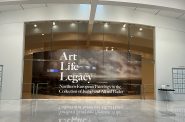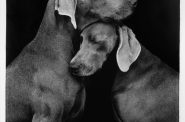The Milwaukee Art Museum’s dazzling “Color Rush”
This expansive, vibrant survey tracks the evolution of color photography from fantastical innovation to ubiquitous practice.

Nickolas Muray (American, 1892–1965) Christmas Cakes and Cookies, ca.1935. Carbro print. 14 1/2 x 22 5/16 in. (36.9 x 56.6 cm). Collection of George Eastman House. © Nickolas Muray Photo Archives, Courtesy of George Eastman House, International Museum of Photography and Film.
 The exhibition is bookended loosely by the years 1907 and 1981. These extremes mark, respectively, the commercial availability of the Autochrome process for making color pictures, patented by the Lumière brothers, and the publication of a scholarly catalog, The New Color Photography, that firmly signaled its acceptance into the lofty reaches of high art. Color Rush encourages us to shake off contemporary visual apathy and imagine what the world was like when the steady eye of photography began to capture life in dazzling hues.
The exhibition is bookended loosely by the years 1907 and 1981. These extremes mark, respectively, the commercial availability of the Autochrome process for making color pictures, patented by the Lumière brothers, and the publication of a scholarly catalog, The New Color Photography, that firmly signaled its acceptance into the lofty reaches of high art. Color Rush encourages us to shake off contemporary visual apathy and imagine what the world was like when the steady eye of photography began to capture life in dazzling hues.
The undercurrent of the exhibition of some 200 objects is a story about the relationship of the medium to a public audience. It unfolds slowly and reflects the shifting patterns of art and society through the tumultuous 20th century.
Many technical aspects underpin color photography, but Color Rush does not deal with them overtly. That is, this exhibition is not a primer on how to make color prints. It focuses on the shifting reputation of color photography over decades and its absorption into creative practices and commercial culture.
The exhibition begins within the astute art circles of Alfred Stieglitz and Edward Steichen. Later, it moves into the mass media extravaganza of fashion spreads and Life magazine before blossoming into a broad survey of art photography of the 1960s and ’70s.

Joel Meyerowitz (American, b. 1938). Red Interior, Provincetown, 1977. Chromogenic print, printed 1985. 18 9/16 x 23 3/8 in. (47.15 x 59.37 cm). Milwaukee Art Museum, Purchase, with funds from Christine A. Symchych. © Joel Meyerowitz / Courtesy Edwynn Houk Gallery, New York. Image by John R. Glembin.
Color can bring things to life, but this took some getting used to. As Hostetler explained, some photographs enjoyed the backhanded compliment of being deemed “painterly,” which is to say they bore a surface resemblance to another art form.
Other images, particularly documentary images capturing everything from world conflict to the hardships of the Great Depression and Dust Bowl, were not regarded as having the gravitas of black-and-white photos. It was thought that viewers might be distracted by their delicious tones and miss paying attention to the serious messages at their core.
If there were a wish to be made in this exhibition, it would be for another gallery or two, continuing the discussion to the present: our post-film, digitally-dominant age of Photoshop and easy image manipulation. But that is another story. For now, this history of photography is important to explore for visual interest and its profound impact on art, advertising and everyday life.
Color Rush: 75 Years of Color Photography in America opens February 22 through May 19, 2013, at the Milwaukee Art Museum, 700 N. Art Museum Drive.
Lead image: Crop of Huntsville, Alabama, 1978, by William Eggleston. © Eggleston Artistic Trust. Courtesy Cheim & Read, New York; image by Efraim Lev-er.
Art
-
Exhibit Tells Story of Vietnam War Resistors in the Military
 Mar 29th, 2024 by Bill Christofferson
Mar 29th, 2024 by Bill Christofferson
-
See Art Museum’s New Exhibit, ‘Portrait of the Collector’
 Sep 28th, 2023 by Sophie Bolich
Sep 28th, 2023 by Sophie Bolich
-
100 Years Of Memorable Photography
 Sep 18th, 2023 by Rose Balistreri
Sep 18th, 2023 by Rose Balistreri


















looks very interesting! Thanks!
Great review, Kat! I’ve been there to the MAM a number of times to see the Color Rush show since its opening (with different curators making comments, plus to the opening lecture), and it’s well-worth seeing – the travails of photography to try to become an art form and a memory-grabber rather than just literal representations of heroes and what we should be (as Time Magazine first showed us).
Great review, Kat, and it’s a show well-worth seeing!
amazing fidelity and sensitivity in the earliest attempts which are replicated for the exhibit and seen on first entering.
Thank you SO MUCH for the tickets! The exhibit was incredibly comprehensive, and I really learned a lot about people like Edward Steichen and other amazing pioneers in the medium.